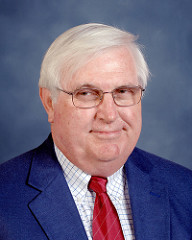UT is ‘Ground Zero’ for Research on Little-Known Oil Recovery Techniques
By Austin Hamby
Reporting Texas
The University of Texas at Austin’s graduate program in petroleum engineering was ranked the best in the country this year by U.S. World & News Report. One reason for the program’s success is Larry Lake, a widely acknowledged expert in enhanced recovery techniques for oil reservoirs at the Cockrell School of Engineering.
To understand the role such methods play, a little petroleum engineering 101 is in order: Say you drill a standard well and oil rises naturally from deep underground toward the surface—that’s “primary recovery.” Inject water or air to add pressure to release the oil, and that’s “secondary recovery.” Use “enhanced recovery techniques,” including injecting steam, fire or chemicals, and you can bring even more oil to the surface.
While many people have heard of fracking, the process whereby water and chemicals are used to free oil trapped in shale formations, the practice by petroleum engineers injecting steam into a well to recover more oil (one form of enhanced recovery) is lesser known.
In a national climate that has long had politicians calling for energy independence, enhanced recovery techniques have helped the U.S. to produce record amounts of oil in recent years, according to the U.S. Energy Information Administration.
Today, with oil trading south of $50 a barrel, or roughly half the levels of 18 months ago, enthusiasm for oil recovery in general has waned due to a worldwide glut. Even so, enhanced recovery techniques will continue to play a major role in a world largely reliant on fossil fuels.
Reporting Texas recently spoke with Lake about the oil extraction methods that he is credited with advancing. Herewith are excerpts from that conversation:

Larry Lake
What is important for ordinary people to know about enhanced oil recovery?
Enhanced recovery is kind of like cleaning your plate after dinner. You want to make sure you get every bit of the food… It’s a conservation issue. There is a resource there, and you should get as much out of it as you can.
How do you know which enhanced techniques to use when?
[Using] thermal is like when you heat up syrup for your pancakes, and [it eases the] flow. Chemical is like a washing machine– basically it takes the grease out… Solvents [are] like dry cleaning… you take [it in] to see what maybe they could do to extract [the oil].
What are some of the advantages of enhanced recovery in today’s depressed oil market?
There is very little drilling involved. Basically, you use existing wells, and there is not much uncertainty about where the hydrocarbon is, because you have already been producing it.
How much oil can you produce with each of the three major recovery techniques?
[Of the oil originally found in a reservoir] it’s about 10 percent on primary [recovery]… 25 percent on secondary, which is usually water flow, and then it’s another 10… or 15 percent on enhanced oil return.
How long does each of those methods continue?
In most cases there has been a period of 20 years… of primary production, a period of 40 years… of secondary production, and then the tertiary or enhanced oil recovery [comes] after that. So total field life would be 80 years… Things move pretty slowly.
How did you become interested in enhanced recovery?
It involves many different fields, like physics, chemistry, hydrodynamics, a little bit of mechanics, and some geology… So of all the different aspects of petroleum engineering, this is the one that brings together the most academic topics in one place.
What would you say about oil engineering to people who have seen oil geysers on television?
The ones with the geyser coming out are very notable exceptions. You see them on TV or the movies… but they’re very much a minority. First of all… it’s wasteful and companies don’t like that to happen, and sometimes there is not enough pressure for [the oil] to come out by itself.
At what per-barrel price do enhanced recovery techniques become profitable?
Somewhere [around] $50 per barrel is required to start new projects.
How do you think the media has covered this topic?
Almost all the attention is based on conditions with drilling and fracking. There has been almost no attention paid to enhanced oil recovery. So I have to say that they have not done a very good job.
What are the risks of enhanced recovery techniques compared to fracking?
There aren’t many risks associated with fracking either, but the risks associated with [enhanced recovery] are… not getting your money back.
What kind of research typically comes out of the University of Texas?
We are basically ground zero in the world for enhanced recovery research, all kinds of it. But it isn’t just that. It’s the fracking research, the unconventional research, economics, all sorts of things that we do… and there aren’t many petroleum departments that can claim that.